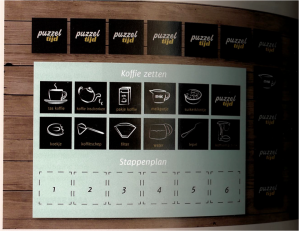
As a student designer, it’s not uncommon for me to go to the studio, put in my headphones, and escape into my own little world for a couple of hours to work on a project. While friends give me some advice along the way, I decide on the design content and the techniques. It’s relaxing and liberating to put in headphones and let your own feelings dictate a design.
But what if a client got to be involved in the design process, not only having a voice in the decisions but also contributing to the art? Instead of wearing headphones throughout the design journey, the designer would need to constantly listen to the other person’s opinions and needs. In Germany, a project called the Dementia Lab (D-Lab) Master’s Module has taken on this challenge with the goal of providing design services that improve the quality of life for people living with dementia.
I learned about the D-Lab Master’s Module through a book called Developing Citizen Designers by Elizabeth Resnick (2016), an inspiring resource for any graphic designer interested in the use of design as service. This project for the dementia lab stood out to me as it not only seeks to help a group of people seldom addressed by designers but also makes these people crucial to the design process. Students in Germany have been carrying out this project every year since 2011. Each student has the mission:
“to make the life of a person with dementia more aangenaam, a Dutch word which means nice, pleasant, and lovely.” (Pg. 227)
To achieve this goal, research plays as much a part in the process as design. A student focuses on one individual to assist and puts a high priority on including that person throughout the entire design journey, focusing on designing with instead of designing for. When the design prototype comes to completion, it has been so greatly influenced by the individual that the design would have been distinctly different without his/her input.
The project’s emphases and the quality of the designs make the Dementia Lab Master’s Module a prime example of participatory design. Taking ideas from community members and using those ideas to create designs stands at the core of the participatory design movement. This movement first started in Scandinavia in the 1970s where workers made contributions to the changes in technology in their workplaces and has now become a part of mainstream culture in the US and abroad. When this process gets executed well, it enables the expression of voices, starts interaction with users from the beginning of the design process and focuses on co-creation (Developing Citizens, 190-191). One writer from the Developing Citizen Designers book, Helen Armstrong, has written her own book on this movement called Participate: Designing with User-Generated Content, where she discusses how designers can thrive in the participatory design movement.

So how have the students focused on the Dementia Lab project created designs that stand out in the area of participatory design? One student’s project has taken on the task of creating a coloring book better suited for the elderly. Student Sara Nysten has a grandfather with dementia who used to color in children’s coloring books as part of his daily exercises. Sara designed a coloring book with imagery related to the 1950’s that relates to her grandfather’s life experiences (Pg. 231). Not only do the designs look interesting and well suited for coloring, but they have achieved the goal of creating a meaningful object and habit for this individual.

Another student, Goele Peeters, had a grandmother diagnosed with dementia who was frustrated by her husband’s attempts to carry out the routine house duties. Goele knew her grandmother loved playing cards and so developed a game that when played, triggers memories on how to complete the task of making a cup of coffee. With whimsical line drawings and a sophisticated color palette, this game succeeds in the areas of graphic design appeal as well being an activity that the individual with dementia will willingly engage in to improve her quality of life.
By learning about the Dementia Lab Master’s Module, I have come to realize how art benefits society when the people being served have an active voice in the design decisions. I’ll continue to wear headphones while I work some of the time, but I also want to take on projects of collaboration, where an individual can participate in the design process. By listening to the people being served, the students working at the Dementia Lab in Germany have created designs that will be more than personal portfolio pieces, they will allow a few lives to be lived just a little bit better.
Learn more about the Dementia Lab Master’s Module through:
Website: http://www.dementialab.com/The-Role-of-Design-2016/
Developing Citizen Designers, Resnick (2016)

